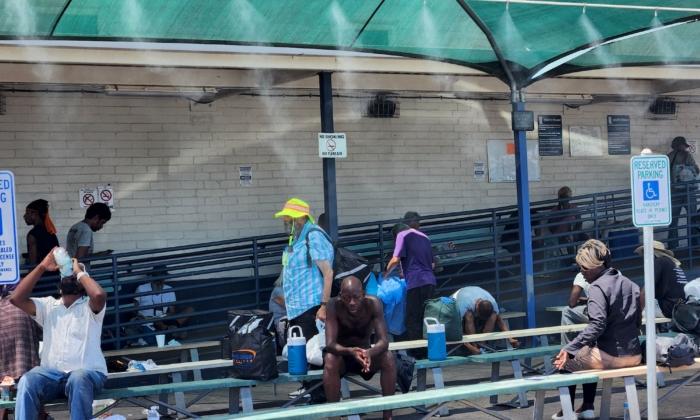PHOENIX, Ariz.—All across America’s arid southwest, the temperatures have been brutal—and lethal—this past month with little relief as states continue to report more heat-related deaths.
In Arizona’s largest and most populated county, Maricopa, the annual death toll rose to 39, with 14 confirmed new cases reported by the end of July.
At least 312 cases are currently under investigation by the county medical examiner’s office as possible heat-related deaths.
And as the numbers continue to climb, the county is taking no chances with 10 portable morgues delivered to an undisclosed location.
Maricopa’s communications director, Fields Moseley, said the county’s Department of Emergency Management contracted for the portable coolers to prepare for a possible surge in the days ahead.
The record-breaking heat wave—one of the region’s longest-running—officially began on July 10.
Weather forecasters predict 100-plus-degree temperatures this week and possibly beyond. It means the death toll will likely rise in Maricopa County and across the state and region.
“We are currently at 63 percent of our total capacity” at the county morgue, Mr. Moseley told The Epoch Times.
Prudent Planning
The county last rented portable coolers to store the deceased in 2020 during the COVID-19 pandemic.“You always have to leave capacity in case of a mass casualty event,” Mr. Moseley said. “It’s just prudent planning. You don’t wait for the emergency—you get out ahead of it.”
On average, he said it takes six weeks to complete a medical examiner investigation and final report.
However, the death certificate’s cause and manner of death are produced more quickly but are “subject to change.”
Ninety percent of cases requiring investigation take place within 90 days. The other 10 percent “require more investigation to reach a conclusion,” Mr. Moseley said.
He said the Maricopa County Department of Public Health conducts additional research and posts a report every Wednesday during Arizona’s heat season between May and October.
In 2022, Maricopa County confirmed 42 heat-related deaths and 282 under investigation.

Most of the heat deaths this year (28 percent) occurred among those aged 65 to 74, according to the county’s 2023 Weekly Heat Report.
The majority, 77 percent, occurred outdoors, while nine reported heat deaths occurred indoors.
Heat Alerts Remain
While county health officials expect more scorching temperatures this week and next, Mr. Moseley said late-arriving monsoon rains have temporarily relieved southern Arizona.“When I say break, it’s only rained in a few areas,” he said.
About 30 million people across the United States live with heat warnings as states grapple with the rising death toll and hospital visits for heat-related injuries.
The California Department of Insurance reports that heat-related deaths and illnesses are preventable, “yet more than 700 people die from extreme heat yearly in the United States, including many in California.”
“The Department of Insurance is working on long-term solutions to protect people from the deadly effects of extreme heat waves,” according to the CDI website.
“We are working quickly to have an extreme heat ranking system in place by Jan. 1, 2025, with actions you can take to protect yourself and your family.”
In Texas, health officials reported about 300 heat-related deaths in 2022, making it one of the deadliest years in more than two decades. This past June, at least 13 people died of heat-associated illness in the Lone Star State.

At least seven confirmed hyperthermia deaths have occurred in Nevada since state health officials began monitoring in April.
According to the Southern Nevada Health District, the state confirmed 152 accumulated deaths from heat-related illness in 2022.
The heat wave has also been deadly for many illegal migrants attempting to gain entry into the United States across Arizona’s porous southern border with Mexico.
The humanitarian group Tucson Samaritans reported at least 13 illegal migrant deaths in June based on Pima County Medical Examiner data.
The organization said it gave over 2,500 gallons of water to nearly 700 illegal migrants and placed 62 crosses.

Stay Cool
In Phoenix, about 363 miles north of the Arizona-Mexico border, city officials have increased the number of cooling stations—especially in vulnerable areas like “The Zone,” a homeless tent enclave of around 800 inhabitants, many homeless seniors.Sabrina, 52, said she became homeless in The Zone about a week ago as the thermometer reached 112 degrees Fahrenheit.
Amidst the debris and squalor of the sprawling homeless encampment, Sabrina feels lucky to be so close to health and human services, water, food, and cooling stations.
A parked, air-conditioned bus served as a cooling center on Aug. 3—its doors whisking open to allow new refugees from the oppressive heat.
“Look at all these people that need help,” Sabrina said. “This is sad.”
“It’s bad for me, but I’m glad I’m [better off] here rather than out there”—away from help, she said.






